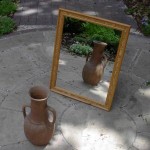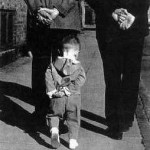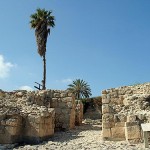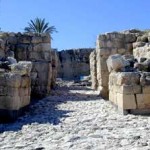The secondary concern with imitation in Scripture
As I mentioned in my post “Lessons in Imitation,” the idea of imitation is very important to the authors of the New Testament. This is especially true of Paul, but John (at least) also exhorts his readers toward imitation. In that post, I listed several of the passages in Scripture in which people were exhorted toward imitation. Those instructions included the imitation of God as well as the imitation of other followers of Jesus (both the authors and others).
When we read through those passages, we can see that the primary concern of the authors is for the readers to consider who they are imitating. In this post, I want to consider another concern about imitation that can only be inferred from those passages, and so is a secondary concern.
What concern is that? While the primary concern of the scriptural authors is for the readers to think carefully about who they are imitating, a secondary concern is for the readers to think about the kind of life they are living and that others are imitating.
Now, before I begin, I need to make something clear. We do not live a certain way because other people are watching us (noticing how we live and following our example, either good or bad). Instead, we live a certain way in obedience to Jesus Christ and in order to glorify God. However, while other people ARE watching us, and they ARE following our example whether we realize it or not. And, being a good example (of a follower of Jesus Christ and child of God) is part of obeying Jesus and glorifying God.
But, even before talking about what it means to live in a way that honors Jesus, there’s another step that we need to consider – a step that I think many among the church are setting aside. What step is that? Actually sharing life with others so that they are able to see your life and you are able to see their life.
Think about it… How can you imitate someone if you do not know how that person lives? How can someone imitate your way of life if they do not know how you live? For too long, the church has relied almost completely on words (either spoken or written) as the primary method of teaching and discipleship. This is not sufficient.
We must begin sharing our lives with one another – every aspect of our lives – yes, even the parts that you wish were not there. Why? Because that’s how real discipleship, teaching, and fellowship takes place. Anything else is a farce – a fake – not reality.
Of course, the church today does not accept this kind of messiness… because life is messy. Instead, we prefer to have things polished, practiced, excellent. And, I think, this is stunting the growth of many Christians.
So, start sharing your life with other brothers and sisters in Christ. Let them see the good and the bad. It’s okay, even if they reject you. And some will.
But, others will accept you as you are, and you will be able to accept them as they are. And, together, you will learn to imitate good and stay away from evil, and together you will grow in maturity in Jesus Christ.
The primary concern with imitation in Scripture
As I mentioned in my post “Lessons in Imitation,” the idea of imitation is very important to the authors of the New Testament. This is especially true of Paul, but John (at least) also exhorts his readers toward imitation. In that post, I listed several of the passages in Scripture in which people were exhorted toward imitation. Those instructions included the imitation of God as well as the imitation of other followers of Jesus (both the authors and others).
When we read through those passages, we can see that the primary concern of the authors is for the readers to consider who they are imitating. They are not to accept just anyone as someone to be imitated. And, in fact, there are no indications that they should accept someone else to imitate simply because others are imitating that person.
While the authors do not always specify reasons to imitate someone else, a few do. Perhaps John write the most general exhortation when he writes, “Do not imitate evil but imitate good.” (3 John 11 ESV) If you read that passage in context, you’ll see that John is actually comparing two different examples that could be imitated: Diotrephes or Demetrius.
Similarly, we see Paul exhorted others to follow him “as he follows Christ,” to follow others in suffering, and to follow others in hard work. The author of Hebrews says to follow someone’s “faith” only after considering “the outcome of their way of life.” (Hebrews 13:7 ESV)
Finally, think again about this passage that Paul wrote to the church in Corinth:
I urge you, then, be imitators of me. That is why I sent you Timothy, my beloved and faithful child in the Lord, to remind you of my ways in Christ, as I teach them everywhere in every church. (1 Corinthians 4:16-17 ESV)
So, not only did Paul encourage the Christians in Corinth to imitate him, but he sent Timothy to them as another example to be imitated. This tells us something important about imitation: we should only imitate people we know and spend time with. “Imitation” in Scripture is about following the example of someone else’s way of life, not simply “following” what the person says.
So, in these passages, the authors are exhorting their readers not only to imitate others, but to carefully consider who they are imitating. And, what is to be considered? The way these people live… what they do… how they respond in difficult situation… are they loving, joyful, peace-filled, etc. even when most people are not?
It is only those who are truly following Jesus consistently that should be imitated. This is the primary concern of the authors of Scripture when they tell their readers to imitate others.
Lessons in Imitation
As I’ve mentioned several times lately, we’re studying through Paul’s letter to the church in Ephesus (Ephesians) when we gather together with the church on Sundays. Of course, our discussions usually spill over into times of conversation and encouragement during the week as we see each other in homes, restaurants, parks, wherever.
This last week, we were scheduled to study the first half of chapter 5 together. As I continued studying through the letter and as I focused on chapter 5 last week, I was intrigued by the first few verses of that chapter.
It starts like this:
Therefore be imitators of God, as beloved children. And walk in love, as Christ loved us and gave himself up for us, a fragrant offering and sacrifice to God. (Ephesians 5:1-2 ESV)
I realized when I read this that I had been pretty jaded. Do you understand how shocking it is to be told to “imitate God”? It truly is jarring when you think about it. Of course, Paul followed that up with “walk in love,” and not just any kind of love, but the same love that Jesus Christ demonstrated when he gave up his life for us.
But, going back to that idea of being imitators… there are many instances in Scripture in which the authors exhort the readers to be “imitators.” I started reading through these difference passages, and I was reminded how important imitation is for followers of Jesus Christ.
Here are a few of the passages:
I urge you, then, be imitators of me. That is why I sent you Timothy, my beloved and faithful child in the Lord, to remind you of my ways in Christ, as I teach them everywhere in every church. (1 Corinthians 4:16-17 ESEV)
Be imitators of me, as I am of Christ. (1 Corinthians 11:1 ESV)
And you became imitators of us and of the Lord, for you received the word in much affliction, with the joy of the Holy Spirit, so that you became an example to all the believers in Macedonia and in Achaia. (1 Thessalonians 1:6-7 ESV)
For you, brothers, became imitators of the churches of God in Christ Jesus that are in Judea. For you suffered the same things from your own countrymen as they did from the Jews… (1 Thessalonians 2:14 ESV)
For you yourselves know how you ought to imitate us, because we were not idle when we were with you, nor did we eat anyone’s bread without paying for it, but with toil and labor we worked night and day, that we might not be a burden to any of you. It was not because we do not have that right, but to give you in ourselves an example to imitate. (2 Thessalonians 3:7-9 ESV)
And we desire each one of you to show the same earnestness to have the full assurance of hope until the end, so that you may not be sluggish, but imitators of those who through faith and patience inherit the promises. (Hebrews 6:11-12 ESV)
Remember your leaders, those who spoke to you the word of God. Consider the outcome of their way of life, and imitate their faith. (Hebrews 13:7 ESV)
Beloved, do not imitate evil but imitate good. Whoever does good is from God; whoever does evil has not seen God. (3 John 1:11 ESV)
While most of these examples are from Paul’s letters, at least one is from a different author. (Perhaps two are fum a different author, if Hebrews was not written by Paul.) In fact, the most general exhortation is from John when he writes, “Do not imitate evil, but imitate good.”
So, why do you think imitation was so important to these early followers of Jesus?
Scripture… As We Live It #235
This is the 235th passage in “Scripture… As We Live It.”
Give thanks in all circumstances just before you eat a meal (especially if you eat in a restaurant) and on a special day set aside for giving thanks; for this is the will of God in Christ Jesus for you. (1 Thessalonians 5:18 re-mix)
(Please read the first post for an explanation of this series.)
A Hymnal of Thanksgiving Carols
A few years ago, our family and a friend were lamenting the fact that stores and radio stations were already playing Christmas music even though it was still weeks before Thanksgiving. But, then we realized that there really were no good Thanksgiving songs – at least, not like the foot-tapping Christmas songs. So, we wrote some Thanksgiving Carols of our own, to the tune of popular Christmas songs.
I’ve shared these on my blog before, but I’ve never shared them all in one post. I hope you enjoy these, and feel free to sing them with your family and friends around your Thanksgiving dinner… we do.
———————————
Silent Turkey
(to the tune of Silent Night)
Silent turkey
Golden baked turkey
Give me some breast
Give me a thigh
Add some ‘taters
Pile ’em high
And a slice
Of pumpkin pie
I will loosen my belt
I will loosen my belt
———————————
Something Smells
(to the tune of Silver Bells)
Something Smells
Something Smells
Have you just burned all our dinner
Should I spray
The stink away
And have a take-out Thanksgiving Day
Cooking turkey, cooking dressing
Cooking dish after dish
In the air there’s the smell of Thanksgiving
Baking brownies, and a few pies
We’ll have all that you wish
But eventually everyone hears
———————————
Tommy the Turquoise Turkey
(to the tune of Rudolph the Red-Nosed Reindeer)
[optional intro]
You know cranberries and football and dressing piled high
Pilgrims and indians and pumpkin pie
But do you recall the best part of Thanksgiving of all
Tommy the Turquoise Turkey (turkey)
Had a very shiny tail (like a blue whale)
And if you ever saw it (saw it)
You would think it was so swell (that’s swell!)
All of the other turkeys (turkeys)
Use to peck and strut about (like a turkey)
When they stood next to Tommy (Tommy)
They made sure that he stood out (pick Tommy!)
Then one cold Thanksgiving eve
Farmer came to say (Yo Yo Yo)
“Tommy with your tail so bright
I need you this very night.”
Then all the family loved him (loved him)
As they gobbled Tommy down (gobble gobble)
Tommy the Turquoise Turkey (turkey)
You’re the yummiest bird around (yum yum)
You’re the yummiest bird around (yum yum)
———————————
Here Comes Thanksgiving
(to the tune of Here Comes Santa Claus)
Here comes Thanksgiving
Here comes Thanksgiving
Long before Christmas Day
No jingle bells, no Christmas trees
No songs about a sleigh
We will eat and we will sleep
We’ll watch some football games
Cause it is almost Thanksgiving
And it’s long before Christmas Day
———————————
Giblet Gravy
(to the tune of Jingle Bells)
Giblet gravy, giblet gravy
What is it anyway?
Pour some on my dressing, please,
Don’t let it run away.
Giblet gravy, giblet gravy
What is it anyway?
Oh, I don’t care, I’ll eat it up
Cause it’s Thanksgiving Day!
———————————
Good Christian Men Eat Up
(to the tune of Good Christian Men Rejoice)
Good Christian men eat up
With fork and knife and cup
Give ye heed to what we say (gobble, gobble)
This is surely Thanksgiving Day
Macy’s floats and Pilgrim hats
You know Black Friday’s coming fast
Turkeys were made for this
Turkeys were made for this
———————————
The First Thanksgiving
(to the tune of The First Noel)
The first Thanksgiving the pilgrims did eat
And invited the indians to their feast
They all had turkey and venison
But they did not watch football; there was no ESPN
Thanksgiving, Thanksgiving
Thanksgiving, Thanksgiving
Let’s all sing some carols for Thanksgiving.
The City Gates and Other Community Gatherings
As I explained in my post “The Church, the Synagogue, and the City Gates,” at least one scholar has concluded that the Jewish synagogue finds its origin in the community activities related to the “city gates” instead of the worship activities related to the temple. Since the early followers of Jesus Christ were greatly influenced by their experiences as part of the first century synagogue, understanding how the synagogue began and what types of activities happened as part of the synagogue can help us also understand the early church.
The gates of various cities are mentioned many times in Scripture. Often, people are said to pass into or out of the gates. Thus, the gates simply represent access to a city. In other passages, gates are said to be barred or fortified, representing the protection or defense of the city. Also, I’ve looked at a few passages in which the king sat on his throne at the gates of the city and other passages in which elders of the community sat at the city gates. I also looked at community legal issues which were associated with the city gates. In this post, I look at examples of other community gatherings in the city gates.
So far, each of the examples have shown some type of community gathering in the city gates. Here are some examples of other community gatherings in the gates that don’t fall into the other categories (king, elders, legal issues):
As soon as he mentioned the ark of God, Eli fell over backward from his seat by the side of the gate, and his neck was broken and he died, for the man was old and heavy. He had judged Israel forty years. (1 Samuel 4:18 ESV)
Then Saul approached Samuel in the gate and said, “Tell me where is the house of the seer?” (1 Samuel 9:18 ESV)
And Absalom used to rise early and stand beside the way of the gate. And when any man had a dispute to come before the king for judgment, Absalom would call to him and say, “From what city are you?” And when he said, “Your servant is of such and such a tribe in Israel,” Absalom would say to him, “See, your claims are good and right, but there is no man designated by the king to hear you.” Then Absalom would say, “Oh that I were judge in the land! Then every man with a dispute or cause might come to me, and I would give him justice.” (2 Samuel 15:2-4 ESV)
When I went out to the gate of the city,
when I prepared my seat in the square,
the young men saw me and withdrew,
and the aged rose and stood;
the princes refrained from talking
and laid their hand on their mouth;
the voice of the nobles was hushed,
and their tongue stuck to the roof of their mouth. (Job 29:7-10 ESV)
There are many other passages which mention the gates of various cities in many different cultures. Many of these are related to the health and welfare of the community. We can see that the people of the city took care of many different community issues in the city gates. (It’s interesting that Job 29:7 associates “the gate of the city” with “my seat in the square” – with some translations preferring “my seat in the street.”)
If the synagogue originated in the activities that took part in the “city gates” of ancient cities, and if the early Christians carried over many of these activities into their own gatherings, then we could expect the church (especially the ones which included many Jewish believers) would include this same focus on community activities.
The City Gates and Community Legal Issues
As I explained in my post “The Church, the Synagogue, and the City Gates,” at least one scholar has concluded that the Jewish synagogue finds its origin in the community activities related to the “city gates” instead of the worship activities related to the temple. Since the early followers of Jesus Christ were greatly influenced by their experiences as part of the first century synagogue, understanding how the synagogue began and what types of activities happened as part of the synagogue can help us also understand the early church.
The gates of various cities are mentioned many times in Scripture. Often, people are said to pass into or out of the gates. Thus, the gates simply represent access to a city. In other passages, gates are said to be barred or fortified, representing the protection or defense of the city. Also, I’ve looked at a few passages in which the king sat on his throne at the gates of the city and other passages in which elders of the community sat at the city gates. In this post, I look at the relationships between the city gates and community legal issues.
Many times, legal issues (both those related to the Law of Moses and others) would be taken before the community at the city gates. Here are a few examples:
Now Ephron was sitting among the Hittites, and Ephron the Hittite answered Abraham in the hearing of the Hittites, of all who went in at the gate of his city, “No, my lord, hear me: I give you the field, and I give you the cave that is in it. In the sight of the sons of my people I give it to you. Bury your dead.” (Genesis 23:10-11 ESV)
So Hamor and his son Shechem came to the gate of their city and spoke to the men of their city, saying, “These men are at peace with us; let them dwell in the land and trade in it, for behold, the land is large enough for them. Let us take their daughters as wives, and let us give them our daughters…” (Genesis 34:20-21 ESV)
…then you shall bring out to your gates that man or woman who has done this evil thing, and you shall stone that man or woman to death with stones. (Deuteronomy 17:5 ESV)
Now Boaz had gone up to the gate and sat down there. And behold, the redeemer, of whom Boaz had spoken, came by. So Boaz said, “Turn aside, friend; sit down here.” And he turned aside and sat down. (Ruth 4:1 ESV)
Interestingly, the first example (from Genesis 23) records Abraham taken possession of some land from Ephron the Hittite by going before the people in the city gates with Ephron. As we saw with the “elders” in the previous post, this shows that the practice of gathering at the city gates (especially for taking care of legal issues) was not a practice of the Hebrews only. Instead, it was a cultural practice. (By the way, the suggestion is that this practice – i.e., gathering at the city gates – only changed when the culture changing being influenced by Hellenistic culture and moving the community gatherings away from the gates and toward the city center.)
What can we learn about the important of the city gates and the community based on these passages about legal issues?
The City Gates and the Elders of the Community
As I explained in my post “The Church, the Synagogue, and the City Gates,” at least one scholar has concluded that the Jewish synagogue finds its origin in the community activities related to the “city gates” instead of the worship activities related to the temple. Since the early followers of Jesus Christ were greatly influenced by their experiences as part of the first century synagogue, understanding how the synagogue began and what types of activities happened as part of the synagogue can help us also understand the early church.
The gates of various cities are mentioned many times in Scripture. Often, people are said to pass into or out of the gates. Thus, the gates simply represent access to a city. In other passages, gates are said to be barred or fortified, representing the protection or defense of the city. Also, I’ve looked at a few passages in which the king sat on his throne at the gates of the city. In this post, I look at the relationships between the elders of a community and the city gates.
There are many passages in the Old Testament in which the elders of a city are said to be gathered “at the gates” of that city. Here are a few of the passages:
And if the man does not wish to take his brother’s wife, then his brother’s wife shall go up to the gate to the elders and say, “My husband’s brother refuses to perpetuate his brother’s name in Israel; he will not perform the duty of a husband’s brother to me.” (Deuteronomy 25:7 ESV)
[The man who committed manslaughter] shall flee to one of these cities [of refuge] and shall stand at the entrance of the gate of the city and explain his case to the elders of that city. Then they shall take him into the city and give him a place, and he shall remain with them. (Joshua 20:4 ESV)
Then all the people who were at the gate and the elders said, “We are witnesses. May the LORD make the woman, who is coming into your house, like Rachel and Leah, who together built up the house of Israel. May you act worthily in Ephrathah and be renowned in Bethlehem…” (Ruth 4:11 ESV)
Her husband is known in the gates when he sits among the elders of the land. (Proverbs 31:23 ESV)
So, we see that the elders of the city are said to be sitting “in the gates” of that city. But, who were the elders of a city? To begin with, we should recognize that this idea of “elders” is not really related to the Law of Moses. Instead, many different cultures and societies gave place in their community to the older people of the community. Even in Scripture we find “elders” in Egypt (Genesis 50:7), Midian (Numbers 22:4), and Moab (Numbers 22:7) for example.
These were the older men in the community, respected members of society. These were the people that the others in the community would turn to when they needed advice or counsel or when there were problems or legal matters to deal with. And, the elders (along with others) would gather at the city gates to take care of these community issues.
What can we learn about the “city gates,” the synagogue, and the church from these passages?
The City Gates and the Seat of the King
As I explained in my post “The Church, the Synagogue, and the City Gates,” at least one scholar has concluded that the Jewish synagogue finds its origin in the community activities related to the “city gates” instead of the worship activities related to the temple. Since the early followers of Jesus Christ were greatly influenced by their experiences as part of the first century synagogue, understanding how the synagogue began and what types of activities happened as part of the synagogue can help us also understand the early church.
The gates of various cities are mentioned many times in Scripture. Often, people are said to pass into or out of the gates. Thus, the gates simply represent access to a city. In other passages, gates are said to be barred or fortified, representing the protection or defense of the city.
In this post, I want to point out several Old Testament passages in which the city gates are places where the king sat and ruled the people. Now, after David, there was a palace (house) in Jerusalem which also included a throne. However, the kings of Israel and Judah occasionally spent time seated on their thrones at the gates of the city. This is seen both literally and figuratively in the Old Testament.
Here are a few passages:
Then the king arose and took his seat in the gate. And the people were all told, “Behold, the king is sitting in the gate.” And all the people came before the king. (2 Samuel 19:8 ESV)
Now the king of Israel and Jehoshaphat the king of Judah were sitting on their thrones, arrayed in their robes, at the threshing floor at the entrance of the gate of Samaria, and all the prophets were prophesying before them. (1 Kings 22:10 ESV)
For behold, I am calling all the tribes of the kingdoms of the north, declares the Lord, and they shall come, and every one shall set his throne at the entrance of the gates of Jerusalem, against all its walls all around and against all the cities of Judah. (Jeremiah 1:15 ESV)
While there is not much information given in those passages about the purpose of the king sitting on his throne in the gate, at least one of the passages (2 Samuel 19:8) indicates that the people had direct access to the king while he was seated in the gate. This was apparently so that the king could rule the people directly (by solving problems or answering questions).
In the Jeremiah prophesy, it also looks like a king sitting in the gates indicates control of the city. Of course, this was not a positive prophecy for the Jews, since he was prophesying that foreign kings would set up thrones in the gates of their cities.
By the way, the city gates were important in the life of the community before first king of Israel. It’s interesting that we see the kings continue to use the importance of the city gates in their rule. I suppose it would be easy for the kings to say that they people must always come to the palace. Instead, they decided that the city gates were important enough to the people and to the community that they (at times) spent time among the people at the city gates.
Why do you think the kings would continue to sit on their throne at the city gates? Why do you think this would be important for the community?
The Church, the Synagogue, and the City Gates
The first-century church gathering and the first-century synagogue gathering had much in common. In fact, since all of the first Christians were Jews, their synagogue gatherings greatly influenced how they gathered as the church. (Of course, there were big differences also. And, by the way, it seems that later the medieval church repaid the favor and greatly influenced the medieval synagogue.)
But, where did the synagogue come from? There are many different theories, but it’s really a mystery. Some suggest that the Jews began gathering (i.e., synagogue) when they were dispersed after the Babylonians destroyed Jerusalem and the temple. But, there’s another theory that I find quite interesting.
Levine (The Ancient Synagogue, New Haven: Yale University Press, 2005) suggested that the synagogue does not find its beginning in the temple, but in something quite different:
On the assumption, then, that the first-century synagogue served as a center for a variety of communal as well as religious functions and activities, we now are in a position to look for the framework which served the same (or similar) purposes in earlier centuries. When seen in this light, it becomes clear that the setting for most, if not all, of these activities in previous eras was the city-gate, the main communal setting in cities and towns in the First Temple period. (page 27)
So, according to Levine, the synagogue originated from the community based activities associated with the “city gates” (as found often in the Old Testament). Why and when did the gatherings move away from the city gates? He has a theory for that as well. He concludes that as Hellenistic (Greek) influence rose, and as the Jewish people took on more of the culture and society of Greece, and as Jewish cities became influenced by the Greek city, the locale of community activities moved away from the city gate and toward the city center.
Why is this important? Well, if Levine is correct, then the synagogue was not primarily based on Jewish worship (i.e., temple) but in Jewish community identity and activities. Obviously, since the Jews found their identity in the Hebrew Scriptures, these writings found a prominent place in their community activities. But, this was not the only activity associated with the synagogue.
Scant evidence exists concerning the synagogue before the destruction of the temple in 70 A.D. (at which point the focus of the synagogue definitely changed). So, if Levine is correct and if the synagogue finds its start in the social activities related to the “city gates,” then we can understand more about those activities by studying what happened at the city gates.
Many of these same activities were transferred to the new gatherings of the Christian community after Pentecost. So, studying the “city gate” activities in the Old Testament can help us understand more about the early church as well.
What kind of activities am I talking about? Well, I’ll look at some of those activities in my posts this week as I look at several Old Testament passages concerning the “city gates.”
What do you think? Do you think Levine may be correct that the early synagogue finds is origin in the social and community activities related to the city gates instead of the worship activities related to the temple?










